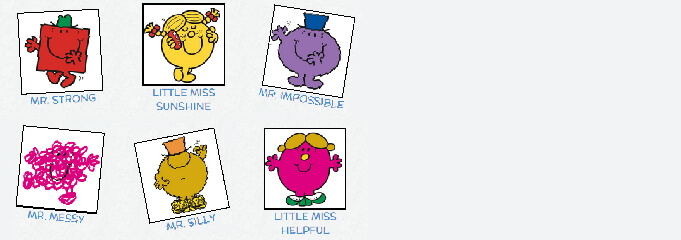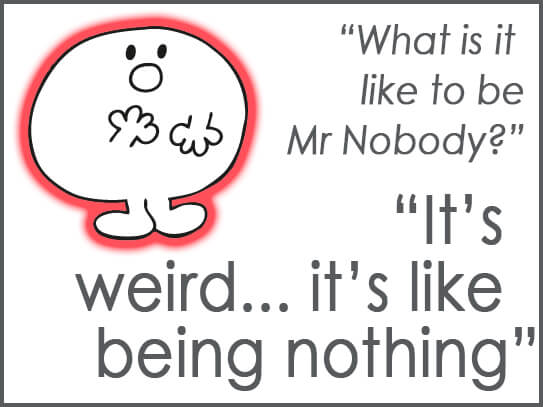
Using the Mr. Men characters – themes in counselling
This article was authored by Sharon Duthie, Senior Counsellor,
Child Trauma Service Victoria, at the Australian Childhood Foundation.
“Who’s this?” I inquired pointing at the self-portrait my seven year old client had painted.
“It’s Mr. Nobody!” the child exclaimed as if it were obvious.
“Oh!” I said. “I wonder what it’s like to be Mr. Nobody?”
“It’s weird,” he said flatly, without affect, not meeting my eyes.
“So it’s weird to be Mr. Nobody,” I reflected back.
“Yeah, it’s like being nothing.”
 The above exchange occurred in a counselling session with a child who has experienced abuse, neglect and several foster care placements. The use of the Mr. Men book series has become a theme in our work together and it has become a lively and beautiful shared language. The other theme that the above exchange echoes is about identity, negative self-concept and unworthiness – sadly common themes we see in many of the children we work with on the Children’s Trauma Service Team at ACF.
The above exchange occurred in a counselling session with a child who has experienced abuse, neglect and several foster care placements. The use of the Mr. Men book series has become a theme in our work together and it has become a lively and beautiful shared language. The other theme that the above exchange echoes is about identity, negative self-concept and unworthiness – sadly common themes we see in many of the children we work with on the Children’s Trauma Service Team at ACF.
Themes hold explanatory frames that recognize children’s specific needs and offer the basis for understanding how to meet those needs.
Joe Tucci, Trauma Informed Thematic Therapy.
In his paper (quoted above), Joe drafts a trauma informed thematic approach to working with children and young people who have experienced complex abuse related trauma. Exploring and understanding the themes our young clients present in sessions helps us to understand how to meet their ongoing therapeutic needs.
Focusing on themes in our work with children is important on many levels. Themes help us track how our clients are progressing through the therapeutic engagement. They also connect the therapist with the child’s mind, thoughts and feelings. They can become an anchor to hold on to and return to, as well as helping to explore other aspects of the child’s functioning. Themes are informed by our understanding of neurobiology of trauma and the child and influence the model of trauma intervention.
 My young client James* has such a negative concept of himself that he thinks he is a nobody, a nothing. Below are several ways we have used the theme of the Mr. Men to develop his self-worth, help him understand his experiencing and to gain better emotional and somatic awareness.
My young client James* has such a negative concept of himself that he thinks he is a nobody, a nothing. Below are several ways we have used the theme of the Mr. Men to develop his self-worth, help him understand his experiencing and to gain better emotional and somatic awareness.
The Mr. Men characters have become a sensorimotor activity for James to connect to his body through movement. We use it as a warm up activity in most sessions. In these sessions James acts out a chosen character – Mr. Rush rushes around the room; Mr. Tickle chases the carer around the room trying to tickle her; Mr. Clumsy bumps into everything and knocks the tissues off the table; Mr. Bounce bounces around the room and Little Miss Somersault rolls around the room. I often ask James to reflect on how he is feeling on the inside after acting out the Mr. Men character.
- We are developing “Mr. Calm”, not an actual Mr. Men character but one that James came up with at home with his carer. Mr. Calm does deep belly breathing and knows when he needs to lie in the bean bag. Mr. Calm is a work in progress and we will write a Mr. Calm therapeutic story in future sessions.
- The Mr. Men Characters have become a metaphor to help my client explain his functioning “This week I was Mr. Perfect, Sharon.” His carer also uses the characters in playful way to inform me in a session how their week has been, for example one session she reported “He was a bit like Mr. Fussy this week as he refused to eat dinner, and then that turned me into Mr. Grumpy.”
- In imaginative play using the dolls house my client has chosen Mr. Men characters for all the dolls in the family. This exploration of family in the context of the dolls house and the Mr. Men characters changes and evolves each time we use this form of imaginative play. Sometimes Mr. Grumpy sits on the roof and won’t let Little Miss Perfect talk to him, other times Little Miss Somersault annoys Mr. Fussy so much that Mr. Fussy gets very angry. Through this type of play, my client acts out many emotional states that he struggles with on a daily basis.
- James chooses to represent the Mr. Men characters in paintings, drawings and other creative modalities. He once painted his feelings of being safe as Mr. Treehead. Obviously not a real Mr. Men character, but by naming the painting he continued, unexpectedly, to integrate our developed theme and shared language. Perhaps a little too perceptively, he once painted me as Little Miss Scatterbrain!
- James has even made up a clever game using the Mr. Men characters. After purposefully and deliberately drawing twelve Mr. Men and Little Miss characters James then carefully cut them out. He turned them all over and the carer, James and I took turns turning them over and acting the cards out until someone guessed the correct character. This activity empowered James to make clear rules about the game as well as providing a sense of accomplishment – so valuable for Mr. Nobody’s sense of self!
With this young client the Mr. Men theme is symbolic, playful and fun. It provides an access or an entry point to process the deeper concerns around this client’s sense of self and how he sees himself in the world. It develops his emotional awareness and deepens his somatic experiencing. It empowers him to take the lead and set limits in the therapeutic context, something he would never do in the outside world.
The Mr. Men theme connects us – James, his foster family and myself, as well as making him feel safe and heard. It also connects James to his lived experience, giving him something to take with him from our sessions to transfer into his daily life. James often extends the therapeutic intervention to his daily routine. “I’ll practice not being Mr. Fussy this week Sharon and try to eat all my dinner.” The Mr. Men have become part of James narrative. As it unfolds it helps to create a cohesive narrative of this child’s identity.
I believe as a therapist it so important to pay attention to what our clients bring to our sessions- we have so many rich therapeutic opportunities when we truly listen to our clients. If I had set aside this clients resonance with the Mr. Men characters and stories I would have missed out on this wonderful co-creation of meaning that has develop in our work together. If he had never painted Mr. Nobody how long would it have taken for me to recognize and respond to his hopelessness and unworthiness, and to meet his needs? James, and the Mr. Men characters have helped me to join him in his world and to assist his trauma recovery in a way that is meaningful for him.
As James’ sense of self becomes more integrated and healing continues, I truly hope that one day this little boy will see himself more as I do – as Mr. Brave and Mr. Strong, and less as Mr. Nobody.
*Not his real name
